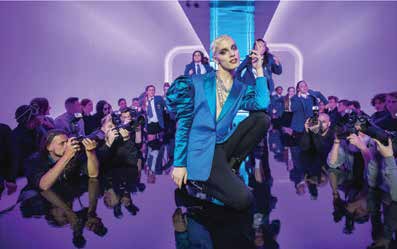
By Gary M. Kramer–
Jonathan Butterell makes a splashy feature film directorial debut with Everybody’s Talking About Jamie, a crowd-pleasing screen adaptation of the hit West End musical he directed back in the U.K. The film opens in local theaters September 10 before streaming on Amazon Prime, September 17.
The openly gay Butterell is, himself, from Sheffield, where the film—based on a true story—takes place. Jamie New (Max Harwood) is a 16-year-old student whose life’s ambition is to become a drag queen. His mum, Margaret (Sarah Lancashire), is incredibly supportive, as is his best friend Pritti (Lauren Patel), but his father (Ralph Ineson) is not. And while Jamie is taunted in school by Dean (Samuel Bottomley), he is encouraged by Hugo (Richard E. Grant), a veteran drag queen.

Butterell’s film is a feel-good coming-of-age story about self-expression and finding one’s place in the world. The upbeat musical sequences are fantastic and imaginative, showing that the director, who has long worked as a choreographer, has substance to match his style. In what may be the most moving and magical sequence in the film, Jamie and Hugo are transported through gay history via images from a videocassette.
The filmmaker met with me for the San Francisco Bay Times to talk about Everybody’s Talking About Jamie.
Gary M. Kramer: Do you know the real Jamie, and did you meet with him to discuss or determine how to feature the character?
Jonathan Butterell: I saw the documentary, Jamie: Drag Queen at 16, about Jamie Campbell. I saw how the support from his mom, classmates, and community shifted around him to make a safe space for him to do that [drag]. And I was inspired by it and needed to tell the story. We created Jamie New to distance Jamie [Campbell] from it if he so chose. He hasn’t done that; he feels totally aligned with it. So, I only got to know Jamie a few weeks before we went into production in Sheffield. We deliberately didn’t talk to him. We wanted to be inspired by his story and not encumbered by it.

Gary M. Kramer: Jonathan, why does this story resonate with you? What can you say about your formative queer teen years?
Jonathan Butterell: They weren’t dissimilar. I come from a working-class background. I grew up in the council house estate [projects] and lived with grandad and mom for a while. My auntie Joan lived literally on the streets where we filmed Jamie. I grew up a queer kid. I’m from a massively extended Irish Catholic family and I had the amazing support and love from all of my family. That might seem at odds for a queer kid. It was a different time, and things got difficult, and could be difficult, but the love and support around me … that’s what inspired me. I struggled to hold on to the story of Jamie not having conflict or being a victim for being gay. It’s not a coming out story, or a victim story.
Gary M. Kramer: Filming dancing is always tricky. There’s a school of thought to show the whole body, but I think it’s appropriate that during “The Wall in My Head” number you focus on Jamie’s new pair of glamourous heels. What can you say about your approach to filming the musical numbers and “opening up” the stage musical for the screen in general?
Jonathan Butterell: I am an advocate of that Fred Astaire quote—you want to see the whole body move through space—and I understand and agree with that. This was different, though. This took the influence of pop video, using editing as a tool within that, and it wasn’t always just about the choreography, though that was a big part of it; it was what was exploding out of Jamie’s imagination. And a lot of it was, in essence, his point of view of what that fantasy might be. The dance element essentially comes from the street. Kate Prince, our choreographer, and her company bring young people from the street into the dance world. [In terms of] the music of the film and the choreographic language of the film, I wanted the working-class audience to recognize it immediately and feel it. It’s their music; it comes out of their radios and young people’s phones. “This Was Me” is reflective of the period and the time, and even “He’s My Boy” is, in terms of being a classic ballad. In my head I was hearing Dusty Springfield singing. It felt in that world, not in the musical theater world. And I’ve lived in musical theatre for 25 years, so I’m not being pejorative about my work!
Gary M. Kramer: The Loco Chanel number, “This Is Me,” where you take us back through gay history via videocassette, is particularly impressive. Can you talk about how you conceived this sequence in particular?
Jonathan Butterell: I felt it essential for “This Was Me” to tell that story in this time and in this context. It is new for the film. I was on those streets, I walked that walk, and went on those marches when Clause 28 essentially criminalized the promotion of homosexuality. “This is Me” feels like a club anthem, and the perfect person to sing that club anthem was Holly Johnson. I felt that, for those people who were there at the time, it would take them back to that time. The story is told from the perspective of Hugo’s lover, who is holding the camera. He’s not conscious of being a chronicler; he’s just watching his lover. I wanted it to be very personal. Of course, it has a polemic nature, but I didn’t want it to feel polemic or that we were being preached at. We were in the life and story of this man and his love.

Gary M. Kramer: The filmcan help empower LGBTQ youth. What observations do you have about the film’s depiction of shame, belonging, disruption, and inspiration? It’s about rule-breaking and finding your inner warrior queen!
Jonathan Butterell: An effeminate young man is portrayed here as the hero, and, in a sense, not just the hero, but as the everyperson. It’s so often that men in stories get to represent the everyman, but women don’t get to do that. So, I wanted this young, unashamed, effeminate young man to represent us all—not just who he is, but all of us. We all deserve to take up space in the world, safely. Every human deserves to have their joy up front in center.
© 2021 Gary M. Kramer
Gary M. Kramer is the author of “Independent Queer Cinema: Reviews and Interviews,” and the co-editor of “Directory of World Cinema: Argentina.” Follow him on Twitter @garymkramer
Published on September 9, 2021
Recent Comments